
Wyoming is a historic home located near Studley in King William County, Virginia. It was built about 1800, and is a two-story, five bay, Georgian style frame dwelling. It has a single-pile, central hall plan and is set on a brick foundation. The house is topped by a clipped gable roof with a standing-seam sheet metal surface and modillion cornice. It measures 55 feet long and 25 feet deep.
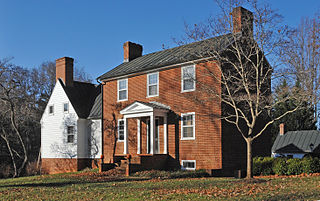
Woodburn, also known as Mundy House, is a historic home and farm complex located near Charlottesville, Albemarle County, Virginia. The original section of the house, built about 1821, consists of a two-story, brick hall and parlor plan Federal style dwelling. It has one-story frame additions to the rear and a skillfully attached 1+1⁄2-story frame wing built in 1983. Also on the property is the Mundy family cemetery.

Ingleside is a historic home located at 10920 Rodophil Road (SR 620) in Rodophil, an unincorporated community in western Amelia County, Virginia. The main section of the house was built about 1824, and is a 2+1⁄2-story, single-pile frame building. It has a two-story, single-pile frame addition added about 1840. The house is in a late Federal style. Also on the property are a contributing two-story frame hay barn sheathed in weatherboard and a 2+1⁄2-story frame tobacco barn.
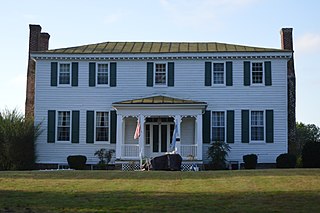
Barrett–Chumney House is a historic plantation house near Amelia Court House, Amelia County, in the U.S. state of Virginia. The house was largely built about 1823, and is a two-story, five-bay frame central-hall building with weatherboarded exterior and hipped standing-seam metal roof. It is a Federal-style I-house with a notable Federal-style door surround. The house was remodeled in about 1859, with the addition of Greek Revival elements. Also on the property are a contributing tobacco barn, two sheds, and a carriage house/garage.
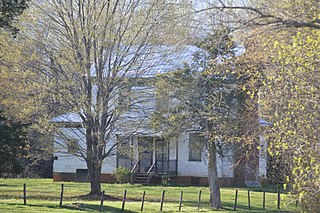
Mount Airy is a historic home located in Bedford County, Virginia, near Leesville. It was built between about 1797 and 1800, and is a two-story, frame, hall-parlor plan house from the Federal period. It has a gable roof and exterior end chimneys. The house received several additions to the side and rear and the front entrance was altered about 1910. The interior retains most of its early woodwork, including a handsomely paneled hall. Also on the property are a contributing smokehouse and family cemetery.
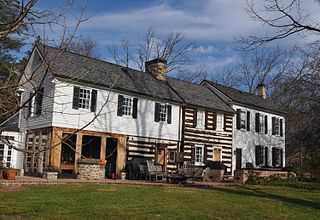
Four Stairs is a historic home located at Great Falls, Fairfax County, Virginia. The earliest section was built about 1737, as a gable-roofed, one-room, one-story with loft log house. It was later enlarged with a shed-roofed west side log pen and rear shed-roofed timber-framed kitchen. These early sections were raised to two-stories after 1796. A two-story, three-bay, parlor-and-side-hall-plan frame addition in the Greek Revival style was built about 1850, and became the focus of the house. The house was restored in 2002–2004. Also on the property are a contributing a family cemetery and a stone-lined hand-dug well.

Weston is a historic home and farm located near Casanova, Fauquier County, Virginia. The original section of the house was built about 1810, with additions made in 1860, 1870, and 1893. The original section was a simple, 1+1⁄2-story, log house. A 1+1⁄2-story frame and weatherboard addition was built in 1860, and a 1+1⁄2-story frame and weatherboard rear ell was added in 1870. In 1893, a two-story frame and weatherboard addition was built, making the house "L"-shaped. This section features a steeply-pitched gable roof with gable dormers and decoratively sawn bargeboards and eaves trim—common characteristics of the Carpenter Gothic style. Also on the property are a number of contributing 19th century outbuildings including the kitchen / wash house, smokehouse, spring house, tool house, blacksmith shop, stable, and barn. Weston is open as a house and farm museum.

Western View is a historic home located near Fork Union, Fluvanna County, Virginia. The original frame section was built about 1790, and expanded with a brick addition in 1824. The original section is a 1+1⁄2-story, two bay, rectangular frame structure with a slate covered gable roof. The brick addition is a one-over-one wing with Greek Revival attributes. Also on the property are the contributing site of the outdoor kitchen with extant chimney, and the Henley/Johnson family cemetery.

High Banks, also known as the Helm-Clevenger House, is a historic home and farm located near Stephenson, Frederick County, Virginia. The house was built about 1753, and is a two-story, three bay by two bay, center-hall, double-pile, limestone dwelling. It has a one-story, two-bay by three-bay frame addition and a frame rear wing. The front porch and interior features detailing in the late Greek Revival were added about 1858. Also on the property are a contributing foundation and partial wall of a post-Civil War bank barn and an 18th-century icehouse pit, both made of stone.

Tinsley Tavern, also known as Tinsleyville Tavern, is a historic inn and tavern located near Columbia in Goochland County, Virginia. It was built about 1802, and is a two-story, vernacular Federal period building. It has a center passage plan, and features wood-frame construction with weatherboard cladding. A 1+1⁄2-story, rear addition dates to about 1920. The building was used as a drover's tavern until 1836, after which it was occupied as a single family home.

Farmington is a historic plantation house located near St. Stephens Church, King and Queen County, Virginia. The original structure was built about 1795, and later enlarged and modified to its present form in 1859–1860. It is a large two-story frame house, with a low-pitch hipped roof and deep eaves. It has a two-story rear addition on the building's southwest side and a one-story addition on the southeast side. Also on the property are a contributing large braced-frame barn, a weaving house, and an overseer's house.

Home Farm is a historic home located near Leesburg, Loudoun County, Virginia. The original log section of the house was built about 1757, with a stone addition built about 1810, a frame addition built about 1830, and a frame kitchen addition built about 1930. It is an "L"-shaped, two-story, single-pile vernacular house clad in wood siding, random rubble fieldstone, and brick veneer laid. The interior exhibits stylistic influences of the Federal style. Also on the property are a contributing early-20th century henhouse, the stone foundation of a spring house, and a dry-laid fieldstone wall.

The Homeplace is a historic home and farm complex located at Madison, Madison County, Virginia. The original house was built about 1830, and is a gable-roofed hall-and- parlor building with a rear shed addition, built of frame over a stone basement. It was extensively enlarged about 1875 by the addition of a two-story wing built on an I-house plan. Also on the property are the contributing barn, well house, sun pit (greenhouse), bunkhouse for farm workers, meathouse, and a building which once housed the furniture factory operated by the Clore family.

Cromer House, also known as Hogan Farm, is a historic home located near Childress, US. The farmhouse was built about 1860 and is a two-story, three-bay, rectangular single pen log structure. It has a massive brick chimney constructed of oversized bricks with pencilled mortar joints. It has a two-story, frame lean-to addition and a frame wing added in the 1930s. Also on the property is a contributing 19th century frame spring house.
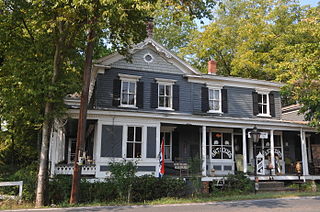
Davis–Beard House, also known as Glee Hall and Davis House, is a historic home located at Bristow, Prince William County, Virginia. It was built after the American Civil War, and is a two-story, five bay, frame I-house dwelling with later additions. The rambling dwelling has a number of Late Victorian style decorative elements. It features a one-story wraparound porch, decorated gables, bay windows, and storefront. Also on the property are a contributing brick hip-roofed carriage house and a small lattice-covered frame privy.
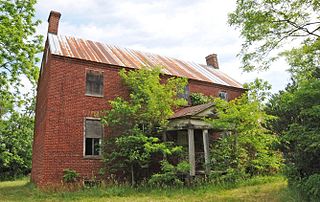
Locust Bottom, also known as Rollingwood Farm, is a historic home and national historic district located near Haymarket, Prince William County, Virginia. The main house was built about 1811, and is a two-story, four-bay, Federal style, brick dwelling with a single-pile, modified central-hall plan. It has end chimneys, a metal gable roof, a molded brick cornice, and a kitchen wing which predates the main house. The two-story rear frame addition was added in the late-19th century. Also included in the district are the shop, the carriage house, the two chicken houses, the brooder house, the milk house, the horse barn, the tenant house, corn crib, and the remains of a smokehouse.

John Hoge House, also known as the Crozier Eaton House, is a historic home located at Belspring, Pulaski County, Virginia. The original section was built about 1800, as a two-story, log dwelling with a hall-parlor plan. In the third quarter of the 19th century, a major frame addition was made to the house, transforming it to a two-story, three bay, central hall plan dwelling. In addition, Greek Revival decorative additions were made to the interior.

Belmont is a historic plantation house where Nat Turner's slave rebellion took place. Located near Capron, Southampton County, Virginia, it was built about 1790 and is a 1+1⁄2-story, frame dwelling sheathed in weatherboard. It has a side gable roof with dormers and sits on a brick foundation. It has a single pile, central-hall plan and features a Chinese lattice railing on the second story. Also on the property are a contributing smokehouse and office. At Belmont, on the morning of August 23, 1831, Nat Turner's slave rebellion was effectively suppressed.

Cedar Ridge is a historic home located East of Disputanta, in Surry County, Virginia. The original one-room section was built about 1750, and later enlarged to a 1+1⁄2-story, three bay, single pile, Colonial frame dwelling. The main house has a later rear addition of an enclosed breezeway connecting to a two-story kitchen and bedchamber addition. The footprint of the house resembles a modified "T" shape. The house was restored, and the chimneys rebuilt, in the late-1970s. Also on the property is a one-story outbuilding that may once have served as slaves' quarters.

Poplar Hall is a historic plantation house located at Norfolk, Virginia. It was built about 1760, and is a two-story, five-bay, Georgian style brick dwelling. It is covered with a slate gable roof and has interior end chimneys. It features a central one-bay dwarf portico and a low, hipped roof topped by a three-bay cupola. Both entrances are sheltered by a dwarf portico. A one-story brick wing was added about 1860, a frame addition in 1955, and a one-story frame wing in 1985. Also on the property is a contributing dairy. The house was built for Thurmer Hoggard, a planter and ship's carpenter who developed a private shipyard on the site.
























